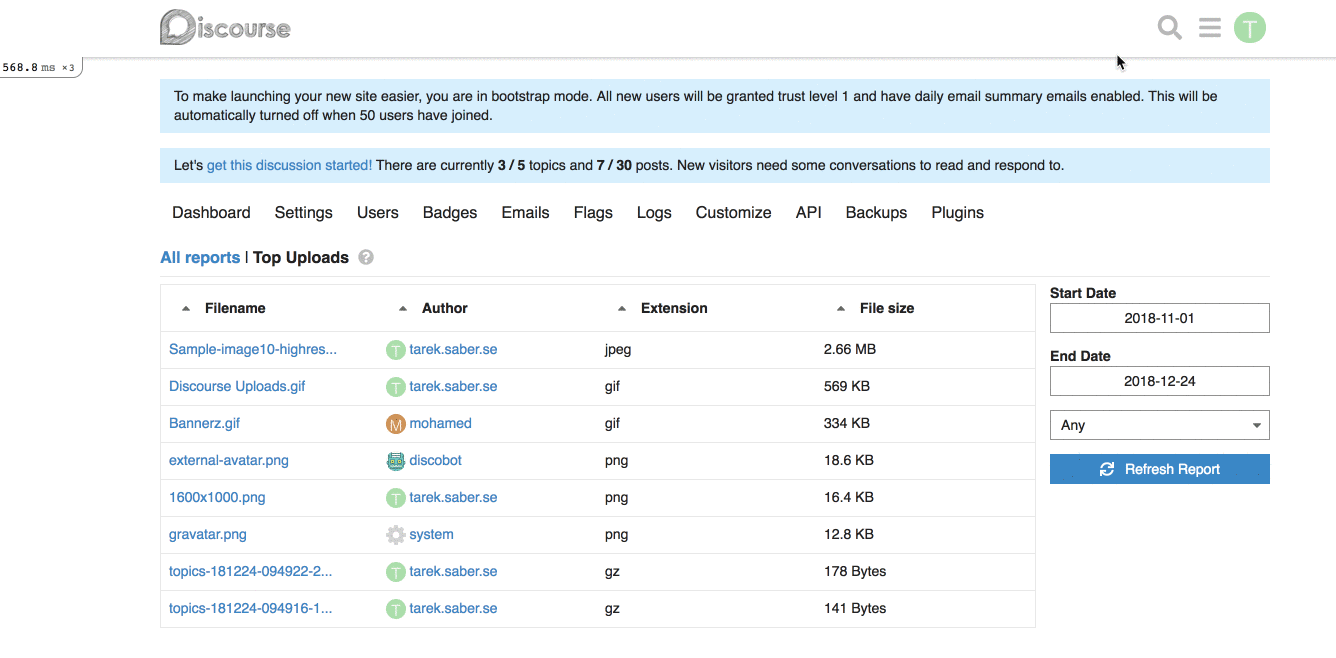- Allow revoking keys without deleting them
- Auto-revoke keys after a period of no use (default 6 months)
- Allow multiple keys per user
- Allow attaching a description to each key, for easier auditing
- Log changes to keys in the staff action log
- Move all key management to one place, and improve the UI
To demonstrate the issue:
- Visit https://meta.discourse.org/#somethingHere while logged in
- Click "log out"
- You will be logged out, but the page will not be reloaded
Setting `window.location.pathname = "/"` will not reload the page if there is a hash present. Using `window.location = "/"` gives us the desired behavior.
* FIX: Cast all numerical values in reports
The backend can return some numerical values in report as strings. That results in unexpected order of values when sorting report tables.
* Create `toNumber()` helper
The `typeof` and `parseFloat` seem to be the fastest path: https://jsperf.com/number-vs-typeof-vs-parsefloat#results
Theme developers can now add any of the transformed color variables to their color scheme in about.json. For example
```
"color_schemes": {
"Light": {
"primary": "333333",
"secondary": "ffffff",
"primary-low": "ff0000"
}
},
```
would override the primary-low variable when compiling SCSS for the color scheme. The primary-low variable will also be visible in administrator color palette UI.
This feature adds the ability to customize the HTML part of all emails using a custom HTML template and optionally some CSS to style it. The CSS will be parsed and converted into inline styles because CSS is poorly supported by email clients. When writing the custom HTML and CSS, be aware of what email clients support. Keep customizations very simple.
Customizations can be added and edited in Admin > Customize > Email Style.
Since the summary email is already heavily styled, there is a setting to disable custom styles for summary emails called "apply custom styles to digest" found in Admin > Settings > Email.
As part of this work, RTL locales are now rendered correctly for all emails.
Theme developers can include any number of scss files within the /scss/ directory of a theme. These can then be imported from the main common/desktop/mobile scss.
Includes support for flags, reviewable users and queued posts, with REST API
backwards compatibility.
Co-Authored-By: romanrizzi <romanalejandro@gmail.com>
Co-Authored-By: jjaffeux <j.jaffeux@gmail.com>
* FEATURE: Exposing a way to add a generic report filter
## Why do we need this change?
Part of the work discussed [here](https://meta.discourse.org/t/gain-understanding-of-file-uploads-usage/104994), and implemented a first spike [here](https://github.com/discourse/discourse/pull/6809), I am trying to expose a single generic filter selector per report.
## How does this work?
We basically expose a simple, single generic filter that is computed and displayed based on backend values passed into the report.
This would be a simple contract between the frontend and the backend.
**Backend changes:** we simply need to return a list of dropdown / select options, and enable the report's newly introduced `custom_filtering` property.
For example, for our [Top Uploads](https://github.com/discourse/discourse/pull/6809/files#diff-3f97cbb8726f3310e0b0c386dbe89e22R1423) report, it can look like this on the backend:
```ruby
report.custom_filtering = true
report.custom_filter_options = [{ id: "any", name: "Any" }, { id: "jpg", name: "JPEG" } ]
```
In our javascript report HTTP call, it will look like:
```js
{
"custom_filtering": true,
"custom_filter_options": [
{
"id": "any",
"name": "Any"
},
{
"id": "jpg",
"name": "JPG"
}
]
}
```
**Frontend changes:** We introduced a generic `filter` param and a `combo-box` which hooks up into the existing framework for fetching a report.
This works alright, with the limitation of being a single custom filter per report. If we wanted to add, for an instance a `filesize filter`, this will not work for us. _I went through with this approach because it is hard to predict and build abstractions for requirements or problems we don't have yet, or might not have._
## How does it look like?

## More on the bigger picture
The major concern here I have is the solution I introduced might serve the `think small` version of the reporting work, but I don't think it serves the `think big`, I will try to shed some light into why.
Within the current design, It is hard to maintain QueryParams for dynamically generated params (based on the idea of introducing more than one custom filter per report).
To allow ourselves to have more than one generic filter, we will need to:
a. Use the Route's model to retrieve the report's payload (we are now dependent on changes of the QueryParams via computed properties)
b. After retrieving the payload, we can use the `setupController` to define our dynamic QueryParams based on the custom filters definitions we received from the backend
c. Load a custom filter specific Ember component based on the definitions we received from the backend
Removing the theme_field JS object when the value was empty caused the server to maintain the previous value, making it impossible to delete the content of a field.
- These advanced fields are hidden behind an 'advanced' button, so will not affect normal use
- The editor has been refactored into a component, and styling cleaned up so menu items do not overlap on small screens
- Styling has been added to indicate which fields are in use for a theme
- Icons have been added to identify which fields have errors